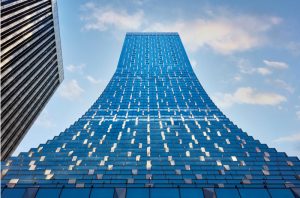High-Rise Structural Innovations and Efficiencies
Downtown Seattle’s 58-story, 850-foot-tall Rainier Square made history when it was completed in November 2020. The $600 million development did more than transform the site of an outdated indoor shopping center into a vibrant, vertically stacked, mixed-use destination offering 1.4 million square feet of space for offices, luxury apartment homes, and retail. It also represented the world’s first high-rise tower successfully built using safe, efficient, and highly innovative SpeedCore as its structural system.

Historically, a high-rise building’s structural system consisted of a central core made of reinforced concrete walls – to resist wind and earthquake forces – surrounded by structural steel floor beams and exterior steel columns. SpeedCore completely reimagines this conventional approach by taking the basic structural components of the traditional concrete core-wall system and turning them inside-out.
Instead of concrete walls with steel reinforcing bars inside, SpeedCore uses steel Concrete-Filled, Composite-Plate Shear Wall (CF-CPSW) modules to eliminate installing rebar and placing and stripping formwork. Developers can build entire structures at the rapid pace of steel construction because SpeedCore’s modular CF-CPSW panels do three jobs at once – support the steel frame above until the concrete is placed, function as the concrete’s formwork, and provide all the concrete reinforcement typically provided by rebar.
Put more simply, SpeedCore’s structural system is akin to an ice cream sandwich, with steel plates serving as the cookies and the concrete serving as the filling.
Risk and Reward
Magnusson Klemencic Associates (MKA) was selected as Rainier Square’s Structural Engineer of Record two years before the project broke ground in 2017. Although backed by more than a decade of research and development championed by MKA and conducted by a variety of reputable industry organizations – the American Institute of Steel Construction, Charles Pankow Foundation, MKA Foundation, Purdue University, Steel Institute of New York, and the University at Buffalo – SpeedCore had yet to be incorporated into a high-rise building. If it were to be used at Rainier Square, the project would serve as SpeedCore’s proof-of-concept.
Fortunately, developer Wright Runstad & Company understood SpeedCore’s sui generis value proposition – namely, how its assembly-line-like efficiency would allow a tower to be erected dramatically faster than if using a traditional structural core system. The developer trusted the project team to deliver this novel structural system successfully, and their decision paid off.
SpeedCore cut 10 months off a potential 32-month schedule if Rainier Square had been constructed with a traditional structural system. The high-rise was erected 43% faster, with four floors completed weekly, resulting in a topping-out milestone just 10 months after the first steel arrived onsite. The savings in general conditions, construction financing interest, and earlier rental revenue streams were significant. In addition, the prefabrication of SpeedCore’s modular panels meant less waste, fewer onsite workers, and fewer truck trips, which all generated positive environmental benefits.
In the end, SpeedCore exceeded the developer’s expectations, with one Wright Runstad & Company executive describing SpeedCore as “my hero core” and adding, “I thank my lucky stars we [did not build with] a concrete core.”
Other Design Innovations
But SpeedCore was not Rainier Square’s only innovation. The project’s engineering also included a Performance-Based Seismic Design and two bi-directional 35,700-gallon water tanks, which serve as dampers on the roof to reduce wind motion.
In addition, MKA incorporated the innovative use of two-story-deep outrigger belt trusses on the 38th floor on two sides of the core to engage six exterior columns for economic increases in overturning resistance. Buckling-Restrained Braces were used in a unique application for the diagonal truss members to provide superior performance during seismic events.
Adding to the complexity, Rainier Square’s seven levels of below-grade parking required a 100-foot-deep excavation extending 50 feet below the mat foundation of the neighboring 40-story Rainier Tower, built in the late 1970s. Geotechnical engineer Hart Crowser provided an impressive temporary earth retention system that allowed Rainier Tower to remain fully occupied during Rainier Square’s excavation despite both towers’ snug proximities.
A Winning Trifecta
Today, Rainier Square is a shimmering, sweeping presence and the second-tallest building on downtown Seattle’s increasingly crowded skyline. It offers more than 730,000 square feet of office space, nearly 200 high-rise apartment homes, a retail podium, and a below-grade parking garage on six levels accommodating nearly 800 vehicles.
But one could argue that the engineering inside this lofty structure is equally impressive.
Rainier Square’s use of SpeedCore is an industry-advancing trifecta of creativity, technical innovation, and design ingenuity that has captured the AEC industry’s imagination and reinvented the rules of high-rise steel construction. The project’s success has led to constructing a 19-story office building in San José, California, using SpeedCore, while other applications are slated for Boston and Oakland.■
